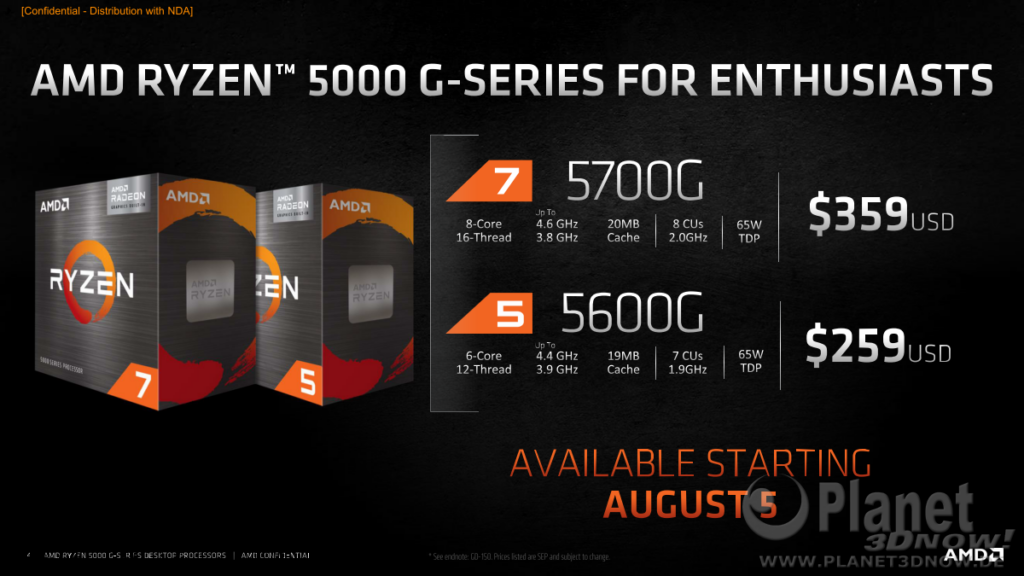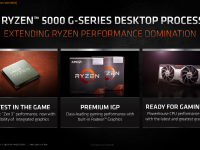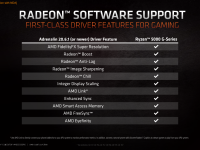AMD Ryzen 5000G ‚ÄúCezanne‚ÄĚ Desktop-APUs erh√§ltlich ‚ÄĒ Review-√úbersicht

Seit Don¬≠ners¬≠tag sind AMDs Ryzen 5000G Desk¬≠top-Pro¬≠zes¬≠so¬≠ren auf Basis von Zen 3 mit inte¬≠grier¬≠ter Vega-Gra¬≠fik erh√§lt¬≠lich. Aktu¬≠ell bele¬≠gen der 8‚ÄĎKerner Ryzen 7 5700G (ab 369 Euro) und der 6‚ÄĎKerner Ryzen 5 5600G (ab 269 Euro) die Pl√§t¬≠ze 1 und 3 beim Preis¬≠ver¬≠gleich Geiz¬≠hals und bei Mind¬≠fac¬≠to¬≠ry sind bereits von bei¬≠den Model¬≠len jeweils fast 1.000 St√ľck ver¬≠kauft wor¬≠den. Nach¬≠fol¬≠gend eine Review-√úber¬≠sicht und die Pr√§¬≠sen¬≠ta¬≠ti¬≠on von AMD.

Deutschsprachige Reviews
- AMD Ryzen 7 5700G im Test: Unse­re Gebe­te wur­den erhört (PC Games Hardware)
‚ÄúHer¬≠aus¬≠ge¬≠kom¬≠men ist ohne Zwei¬≠fel die bes¬≠te Desk¬≠top-APU, die in Spie¬≠len und Anwen¬≠dun¬≠gen glei¬≠cher¬≠ma¬≠√üen √ľber¬≠zeugt und oben¬≠drein noch sehr effi¬≠zi¬≠ent daher¬≠kommt. Die Best¬≠wer¬≠te erreicht ein 5700G aus Sicht der rei¬≠nen CPU-Leis¬≠tung zwar in kei¬≠ner Kate¬≠go¬≠rie, aber im Ver¬≠gleich mit Zen 2 und aktu¬≠el¬≠len Intel-Pro¬≠zes¬≠so¬≠ren schnei¬≠det die Cezan¬≠ne-APU sehr gut ab.‚ÄĚ
‚ÄúAuf¬≠grund von 65/88 Watt hat der Ryzen 7 5700G den Vor¬≠teil, unter Voll¬≠last weit¬≠aus spar¬≠sa¬≠mer als ein Ryzen 7 5800X zu sein, und das mono¬≠li¬≠thi¬≠sche Design ben√∂¬≠tigt √ľber¬≠dies im Leer¬≠lauf weni¬≠ger Ener¬≠gie als der Chip¬≠let-Auf¬≠bau. Hin¬≠zu kommt, dass der Ryzen 7 5700G eine inte¬≠grier¬≠te Vega-Gra¬≠fik¬≠ein¬≠heit auf¬≠weist, mit der sich selbst aktu¬≠el¬≠le Titel wie Gears Tac¬≠tics in 1080p fl√ľs¬≠sig spie¬≠len lassen.‚ÄĚ
- AMD Cezan­ne im CPU-Test: Ryzen 5 5600G und Ryzen 7 5700G gegen Intel Core (Com­pu­ter­Ba­se)
‚ÄúDie inte¬≠grier¬≠te Gra¬≠fik ist, wie im Arti¬≠kel AMD Ryzen 5000G: iGPU im Test: Zen 3 beschleu¬≠nigt die APU im Spie¬≠le-Ein¬≠satz er√∂r¬≠tert, bes¬≠ser gewor¬≠den, ent¬≠spricht aber im Kern immer noch dem Stand von vor vie¬≠len Jah¬≠ren. F√ľr Office-Umge¬≠bun¬≠gen geeig¬≠net, steigt sie nach mehr als einem anspruchs¬≠lo¬≠sen Spiel schnell √ľber¬≠for¬≠dert aus. Der wesent¬≠li¬≠che Makel der neu¬≠en APUs fin¬≠det sich aber an ande¬≠rer Stel¬≠le: F√ľr die Mul¬≠ti¬≠me¬≠dia-Taug¬≠lich¬≠keit, ins¬≠be¬≠son¬≠de¬≠re mit Blick auf die Video¬≠strea¬≠ming-Zukunft, fehlt den APUs mit Vega-iGPU die AV1-Beschleu¬≠ni¬≠gung. Intels CPUs mit Xe-iGPU bie¬≠ten die¬≠se Funktion.‚ÄĚ
Englischsprachige Reviews
‚ÄúWhat AMD has here with the new Ryzen 5000G desk¬≠top APUs is some¬≠thing that fast. Equip¬≠ping up to eight Zen 3 cores around 4.0 GHz in a sys¬≠tem should cater to almost* everyone‚Äôs com¬≠pu¬≠te needs. The new 5000G APUs are gene¬≠ra¬≠tio¬≠nal¬≠ly a real¬≠ly nice impro¬≠ve¬≠ment in raw com¬≠pu¬≠te per¬≠for¬≠mance over 4000G, but becau¬≠se 4000G wasn‚Äôt real¬≠ly at retail, we‚Äôre loo¬≠king at 3000G, and the new hard¬≠ware wipes the flo¬≠or here. The only down¬≠si¬≠de is that AMD didn‚Äôt release the che¬≠a¬≠pest offering.‚ÄĚ
- AMD Ryzen 7 5700G Review: Fas­test Inte­gra­ted Gra­phics Ever (Tom’s Hardware)
‚ÄúAMD‚Äôs Ryzen 7 5700G brings the vaun¬≠ted Zen 3 archi¬≠tec¬≠tu¬≠re and big CPU per¬≠for¬≠mance gains to its APU lin¬≠e¬≠up, and the inte¬≠gra¬≠ted Rade¬≠on RX Vega gra¬≠phics engi¬≠ne pro¬≠vi¬≠des smooth 1080p gam¬≠ing if you‚Äô¬≠re wil¬≠ling to accept lower fide¬≠li¬≠ty set¬≠tings and a limi¬≠t¬≠ed sel¬≠ec¬≠tion of titles. The 5700G also deli¬≠vers unbeata¬≠ble iGPU per¬≠for¬≠mance for 1280x720 gam¬≠ing, but it isn‚Äôt the best value.‚ÄĚ
“We know: If GPUs were ple­n­ti­ful and reason­ab­ly pri­ced, you wouldn’t even be con­side­ring an APU. In the world we live, having a chip with a good gra­phics core is bet­ter than not having any­thing at all you can afford.
That‚Äôs why despi¬≠te its see¬≠mingly pain¬≠ful pri¬≠ce of $359, we think the Ryzen 7 5700G is all win. It can hang with and even beat Intel‚Äôs 11th- and 10th-gen chips in CPU-bound tasks. When it comes to gam¬≠ing per¬≠for¬≠mance using the onboard gra¬≠phics, it sim¬≠ply wrecks them.‚ÄĚ
- AMD Ryzen 7 5700G Review (Tech­Power­Up)
‚ÄúAll this sounds gre¬≠at? Yeah, AMD thinks so, too, that‚Äôs why they‚Äô¬≠ve pri¬≠ced the Ryzen 7 5700G at $360, making it the most expen¬≠si¬≠ve APU to date. Pre¬≠vious APUs were pri¬≠ced at below $200 to make them inte¬≠res¬≠t¬≠ing to ent¬≠ry-level buil¬≠ders who don‚Äôt need a fan¬≠cy gra¬≠phics card for their pro¬≠duc¬≠ti¬≠vi¬≠ty tasks. Today‚Äôs Ryzen 7 5700G does offer much hig¬≠her per¬≠for¬≠mance on both CPU and gra¬≠phics cores, of cour¬≠se, but be pre¬≠pared to pay for that. The pro¬≠blem is that for 1080p gam¬≠ing, the inte¬≠gra¬≠ted gra¬≠phics sim¬≠ply are not powerful enough, not even at the lowest pos¬≠si¬≠ble set¬≠ting. For pure gam¬≠ing, you‚Äôll be bet¬≠ter off with a seve¬≠ral-year-old gra¬≠phics card that sup¬≠ports DirectX 12 pai¬≠red with a value-champ CPU like the Core i5-11400F, Ryzen 3 3300X, or 10400F, in that order. ‚ÄĚ
- AMD Ryzen 5 5600G and Ryzen 7 5700G review (The Guru of 3D)
‚ÄúThe Ryzen 7 5700G, is not appro¬≠pria¬≠te for low-cost set¬≠ups. May¬≠be, depen¬≠ding on the con¬≠fi¬≠gu¬≠ra¬≠ti¬≠on, the 5700G may be ide¬≠al if you‚Äô¬≠re loo¬≠king for a pre¬≠mi¬≠um home thea¬≠ter PC set¬≠up. Right now, we belie¬≠ve the most likely use case is to use the 5700G‚Äôs inte¬≠gra¬≠ted gra¬≠phics as an inte¬≠rim solu¬≠ti¬≠on if you want to wait until the gra¬≠phics card pri¬≠ces sett¬≠le. The Ryzen 5 5600G is a 6‚ÄĎcore vari¬≠ant with a clock speed of up to 4.4 GHz. The GPU has been redu¬≠ced to 7 Vega com¬≠pu¬≠te units with a clock speed of up to 1.9 GHz and the same 16MB L3 cache and is effec¬≠ti¬≠ve for the money at 43 USD per core, that‚Äôs 45 USD per core for the 5700G btw.‚ÄĚ
‚ÄúOff the bat, I will say I‚Äôm on the fence with the¬≠se new APUs, and if I‚Äôm honest, if the Zen 2 powered Ryzen 7 Pro 4750G were easi¬≠ly attainable for con¬≠su¬≠mers, I don‚Äôt think AMD would need to intro¬≠du¬≠ce the¬≠se new SKUs today. I‚Äôm on the fence becau¬≠se while‚ÄĚ tech¬≠ni¬≠cal¬≠ly‚ÄĚ the¬≠se are Zen 3 APUs, they don‚Äôt car¬≠ry with them the full com¬≠ple¬≠ment of tech¬≠no¬≠lo¬≠gy we were intro¬≠du¬≠ced in Novem¬≠ber last year, name¬≠ly PCIe Gen4.
- Review: AMD Ryzen 7 5700G (HEXUS.net)
“Going down the Cezan­ne rou­te does have minor down­si­des, howe­ver, as the SoC runs off PCIe 3.0 and chips car­ry half the L3 cache pre­sent on the latest tran­che of full-on desk­top Ryzens.
Pri­ced at around £329, the Ryzen 7 5700G’s qua­li­ties mean its tar­get mar­ket is niche. Power users tend to run with dis­crete video cards, but such is the sta­te of play with GPU stock shorta­ges, having a capa­ble Ryzen chip with a decent IGP works on mul­ti­ple fronts right now. Enthu­si­asts can choo­se this chip and wait for pre­mi­um gra­phics cards to beco­me more affordable.
Pri¬≠med for high-qua¬≠li¬≠ty SFF and HTPC builds first and fore¬≠most, the arri¬≠val of Ryzen 7 5700G to retail offers DIY buil¬≠ders yet more choice and repres¬≠ents a good decis¬≠i¬≠on from AMD.‚ÄĚ
- AMD Ryzen 5000G Series Review: Zen 3 APUs Deli­ver Big Value (Hot­Hard­ware)
‚ÄúAll told, save for the lack of PCIe Gen 4, there‚Äôs a lot to like with the Ryzen 5000G Series. The¬≠se pro¬≠ces¬≠sors offer strong CPU and inte¬≠gra¬≠ted GPU per¬≠for¬≠mance, in power-fri¬≠end¬≠ly packa¬≠ges, that work in the exis¬≠ting socket AM4 eco¬≠sys¬≠tem, and at com¬≠pe¬≠ti¬≠ti¬≠ve pri¬≠ces. If you‚Äô¬≠re loo¬≠king to build a high-per¬≠for¬≠mance, main¬≠stream sys¬≠tem and want 6 or 8‚ÄĎcore value opti¬≠ons, or inte¬≠gra¬≠ted gra¬≠phics will do, the Ryzen 5000G series is an easy recommendation.‚ÄĚ
Videoreviews
AMD-Präsentation




















